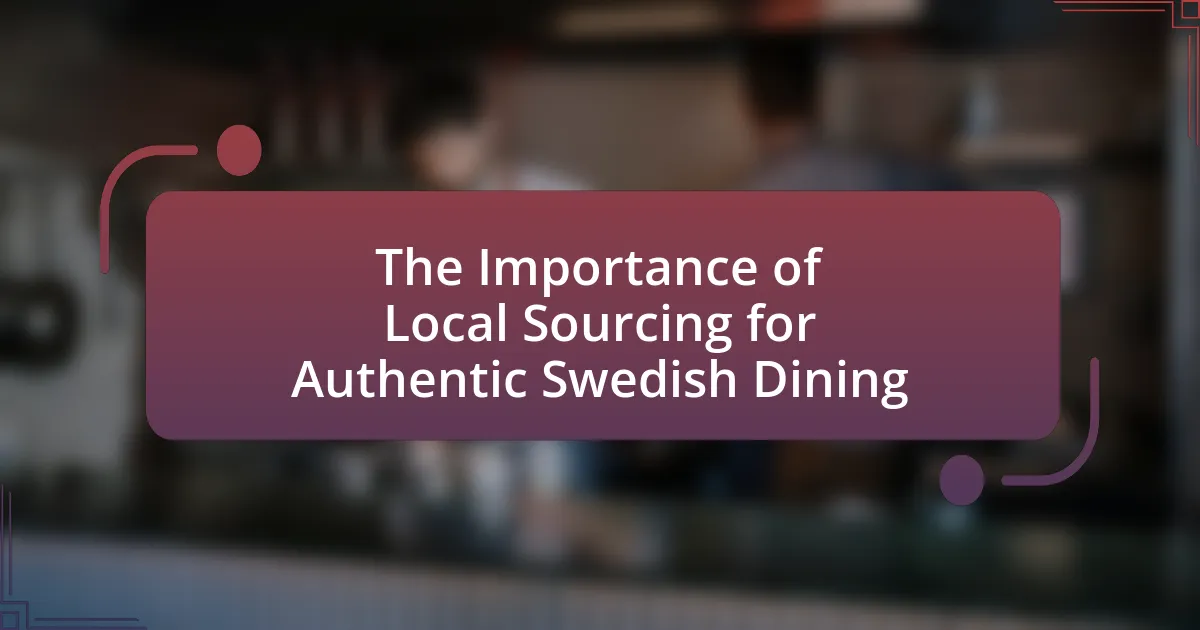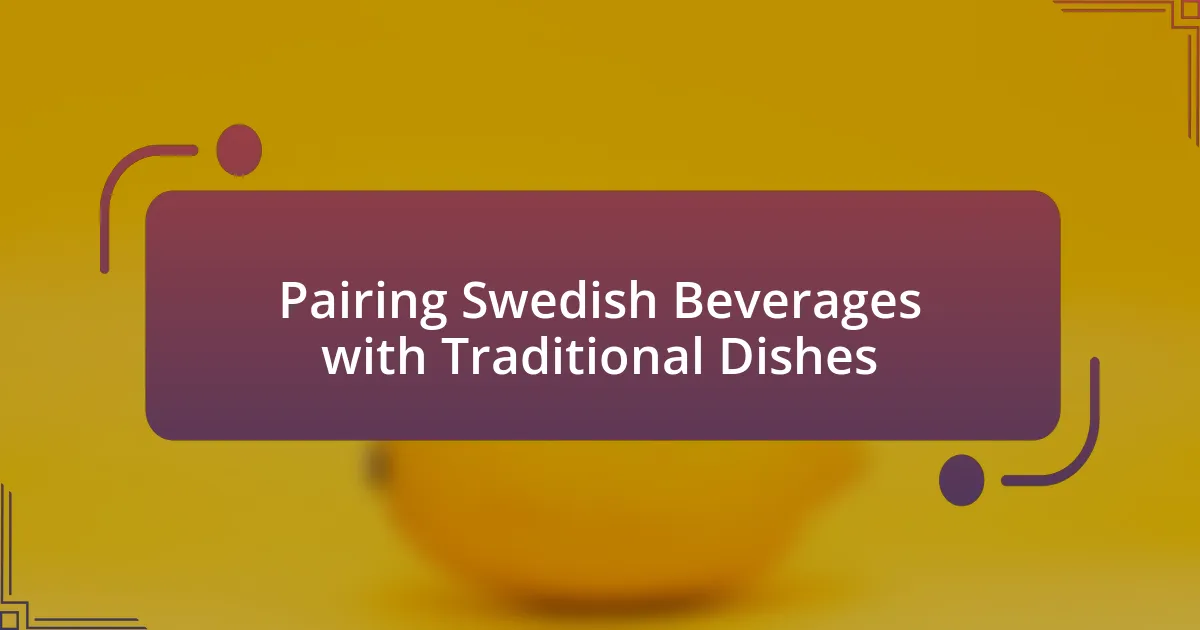Swedish Fika is a cultural tradition that emphasizes taking breaks to enjoy coffee and pastries while fostering social interaction. Originating in the 18th century, Fika has evolved into a significant aspect of Swedish life, promoting community and well-being. This article explores the historical roots of Fika, its key components, and its importance in Swedish culture, particularly in workplace settings. Additionally, it discusses how Fika is practiced in restaurants, the types of food and drink typically served, and best practices for enjoying this cherished ritual.
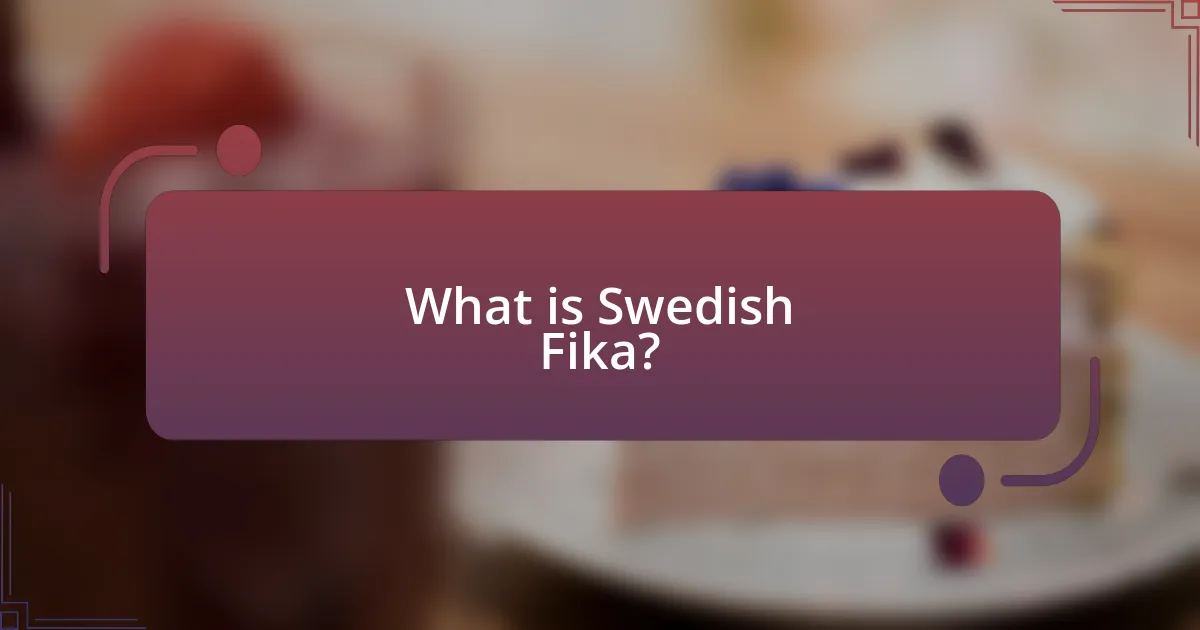
What is Swedish Fika?
Swedish Fika is a cultural tradition in Sweden that involves taking a break to enjoy coffee and pastries, often accompanied by social interaction. This practice emphasizes the importance of slowing down and connecting with others, typically occurring in a relaxed setting, such as a café or at home. Fika is not just about the food and drink; it represents a moment of pause in the day, fostering community and well-being. The concept is deeply ingrained in Swedish society, with many workplaces incorporating regular Fika breaks to enhance employee morale and productivity.
How did the tradition of Fika originate in Sweden?
The tradition of Fika originated in Sweden during the 18th century as a coffee break culture that emphasized social interaction. Initially, coffee was a luxury item, and the practice of taking a break to enjoy coffee and pastries became a way for people to gather and connect. Over time, Fika evolved into a significant aspect of Swedish culture, symbolizing a moment of pause in the day for relaxation and conversation. Historical records indicate that by the 19th century, Fika had become a common practice in Swedish homes and workplaces, reinforcing its role in fostering community and well-being.
What historical events influenced the development of Fika?
The development of Fika in Sweden was influenced by several historical events, particularly the introduction of coffee in the 17th century. Coffee became popular among the Swedish elite, leading to the establishment of coffee houses in cities like Stockholm, which served as social hubs. Additionally, the 18th-century coffee ban imposed by King Gustav III aimed to curb coffee consumption, inadvertently increasing its allure and solidifying its place in Swedish culture. The industrial revolution in the 19th century further popularized Fika as workers sought breaks during long hours, embedding the practice into daily life. These events collectively shaped Fika into a cherished tradition that emphasizes social interaction and relaxation over coffee and pastries.
How has Fika evolved over the years?
Fika has evolved from a traditional Swedish coffee break into a cultural phenomenon that emphasizes social interaction and quality time. Initially, Fika was a simple coffee break enjoyed at home or in small gatherings, primarily focused on coffee and pastries. Over the years, it has expanded to include a variety of settings, such as workplaces and cafes, where it serves as a vital social ritual that fosters community and collaboration. This evolution is supported by the increasing popularity of Fika in modern Swedish society, where it is now recognized as an essential part of daily life, promoting well-being and work-life balance.
What are the key components of a traditional Fika?
A traditional Fika consists of coffee and a selection of baked goods, typically pastries or cakes. The coffee is often brewed strong, and the baked items can include cinnamon buns, cookies, or other sweet treats. This practice emphasizes social interaction, as Fika is not just about the food and drink but also about taking a break to connect with others. The cultural significance of Fika in Sweden is highlighted by its role in promoting relaxation and community, making it an integral part of Swedish lifestyle.
What types of coffee are typically served during Fika?
During Fika, the types of coffee typically served include brewed coffee, espresso, and cappuccino. Brewed coffee, often referred to as filter coffee, is the most common choice, reflecting Sweden’s coffee culture where light roast is preferred. Espresso is also popular, especially in urban areas, and is often enjoyed in various forms, including cappuccinos, which combine espresso with steamed milk and foam. This variety caters to different preferences, ensuring that Fika remains a versatile and enjoyable experience.
What pastries and snacks are commonly enjoyed during Fika?
Pastries and snacks commonly enjoyed during Fika include cinnamon buns, known as kanelbullar, and cardamom buns, referred to as kardemummabullar. These sweet baked goods are traditional staples in Swedish coffee breaks, often accompanied by coffee or tea. Additionally, other popular items include cookies like havregrynskakor (oatmeal cookies) and various types of cakes, such as prinsesstårta (princess cake) and kladdkaka (sticky chocolate cake). The enjoyment of these treats during Fika is rooted in Swedish culture, emphasizing relaxation and social interaction.
Why is Fika important in Swedish culture?
Fika is important in Swedish culture because it serves as a social ritual that fosters community and connection among individuals. This tradition involves taking a break to enjoy coffee and pastries, allowing people to pause their daily activities and engage in meaningful conversations. Research indicates that regular social interactions, such as those encouraged by fika, contribute to improved mental well-being and workplace productivity. In Sweden, fika is not just about the food and drink; it embodies a cultural value of work-life balance and prioritizing relationships, making it a significant aspect of Swedish identity.
How does Fika promote social interaction?
Fika promotes social interaction by creating a designated time for people to gather, share coffee, and engage in conversation. This cultural practice encourages individuals to pause their daily activities, fostering connections through relaxed dialogue and communal experiences. Research indicates that such social breaks enhance workplace relationships and improve overall well-being, as seen in studies highlighting the positive effects of social interactions on mental health and productivity.
What role does Fika play in work-life balance in Sweden?
Fika plays a crucial role in promoting work-life balance in Sweden by providing structured breaks that encourage social interaction and relaxation among employees. This tradition of taking a coffee break, often accompanied by pastries, fosters a sense of community and reduces stress, which contributes to overall well-being. Research indicates that regular breaks, such as Fika, can enhance productivity and job satisfaction, as they allow individuals to recharge mentally and physically. In Sweden, the cultural emphasis on Fika reflects a broader societal value placed on balancing work commitments with personal well-being, making it an integral part of the Swedish work environment.
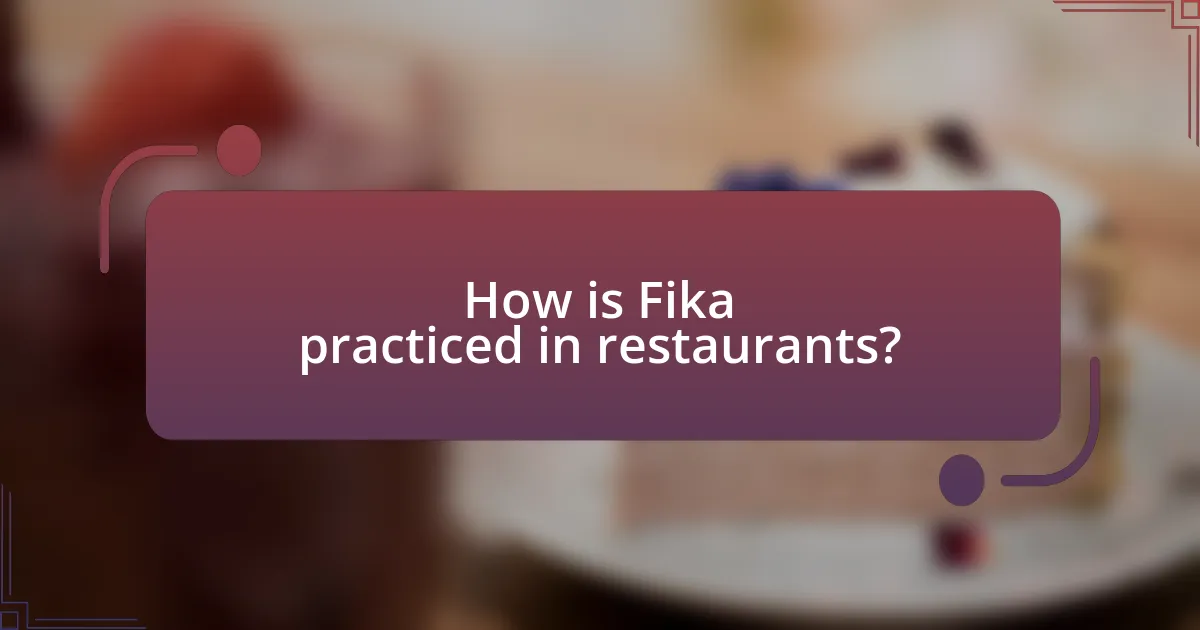
How is Fika practiced in restaurants?
Fika is practiced in restaurants by offering a designated time for coffee and pastries, creating a social atmosphere for patrons. Restaurants typically provide a selection of coffee, tea, and traditional Swedish baked goods like cinnamon buns or cardamom bread, encouraging customers to take a break and enjoy conversation. This practice aligns with Swedish culture, where Fika is seen as an essential part of daily life, promoting relaxation and social interaction. Many restaurants also create cozy seating arrangements to enhance the experience, reflecting the importance of community and connection during these breaks.
What are the common settings for enjoying Fika in restaurants?
Common settings for enjoying Fika in restaurants include cozy, relaxed environments that encourage social interaction. These settings often feature comfortable seating arrangements, such as sofas or armchairs, and tables that allow for both small and large groups. Many restaurants also incorporate natural light and warm decor to create an inviting atmosphere. Additionally, the presence of a dedicated Fika menu, offering coffee and traditional pastries like cinnamon buns, enhances the experience, aligning with the cultural significance of Fika as a time for connection and enjoyment.
How do restaurant atmospheres contribute to the Fika experience?
Restaurant atmospheres significantly enhance the Fika experience by creating a welcoming and relaxed environment conducive to social interaction. The ambiance, characterized by comfortable seating, warm lighting, and inviting decor, encourages patrons to linger and engage in meaningful conversations over coffee and pastries. Research indicates that environments with soft music and pleasant aromas can elevate mood and promote relaxation, which aligns with the essence of Fika as a time for pause and connection. Additionally, the presence of communal spaces fosters a sense of community, allowing individuals to share their Fika moments, thus enriching the overall experience.
What types of restaurants are most popular for Fika?
Cafés and bakeries are the most popular types of restaurants for Fika. These establishments typically offer a cozy atmosphere and a selection of coffee and traditional Swedish pastries, such as cinnamon buns and cardamom rolls. The popularity of cafés and bakeries for Fika is supported by cultural practices in Sweden, where taking a break to enjoy coffee and pastries is a common social activity, often emphasized in local customs and daily routines.
How do restaurants prepare for Fika?
Restaurants prepare for Fika by creating a dedicated menu that features traditional Swedish pastries, coffee, and tea. This preparation involves sourcing high-quality ingredients for items like cinnamon buns, cardamom bread, and various cakes, ensuring authenticity and freshness. Additionally, restaurants often design a cozy atmosphere with comfortable seating and inviting decor to encourage relaxation and social interaction, which are key elements of the Fika experience. They may also schedule specific times for Fika to attract customers, promoting it as a cultural tradition that enhances the dining experience.
What menu items are essential for a successful Fika offering?
Essential menu items for a successful Fika offering include coffee, pastries, and sandwiches. Coffee is the cornerstone of Fika, traditionally served as a strong brew, often accompanied by sweet treats. Pastries such as cinnamon buns, cardamom buns, and cookies are integral, providing a balance of flavors and textures. Additionally, open-faced sandwiches, known as smörgås, can be included to offer a savory option, enhancing the overall experience. These items reflect the cultural significance of Fika as a social and culinary tradition in Sweden, where the combination of coffee and baked goods fosters connection and relaxation.
How do restaurants create a welcoming environment for Fika?
Restaurants create a welcoming environment for Fika by emphasizing comfort, community, and quality. They achieve this through cozy seating arrangements, warm lighting, and inviting decor that encourages relaxation and conversation. Additionally, offering a selection of high-quality coffee and traditional Swedish pastries, such as cinnamon buns and cardamom bread, enhances the experience. The atmosphere is often complemented by friendly staff who engage with customers, fostering a sense of belonging. Research indicates that environments designed for social interaction can significantly enhance customer satisfaction, making the Fika experience more enjoyable and memorable.
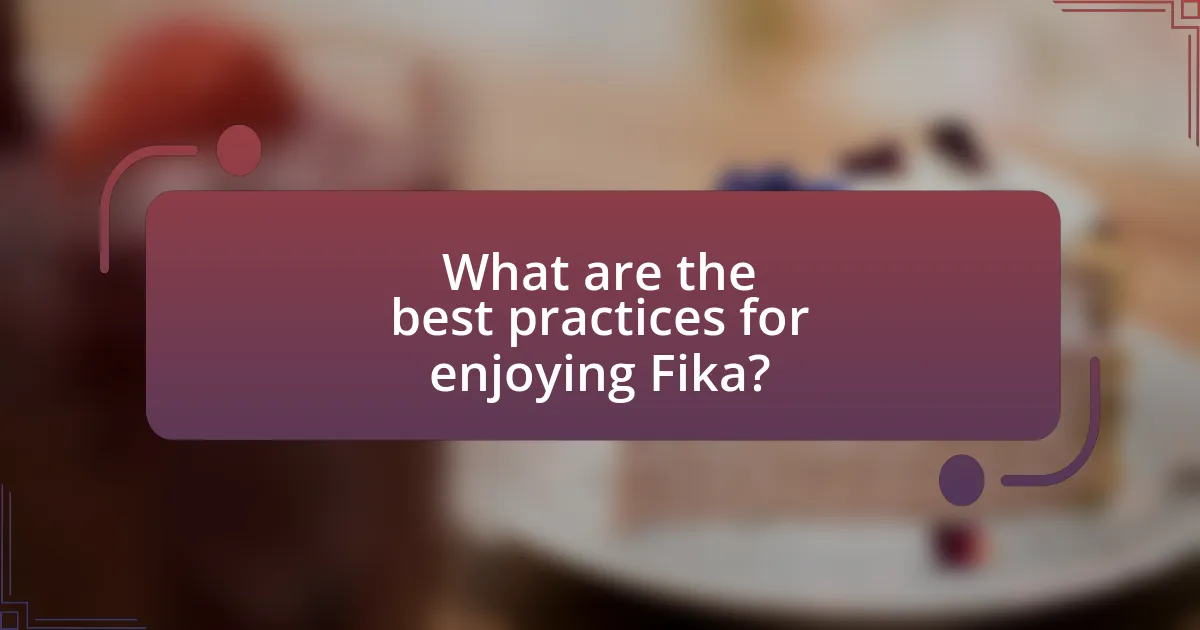
What are the best practices for enjoying Fika?
To enjoy Fika effectively, prioritize taking a break from work to savor coffee and pastries in a relaxed environment. This practice encourages social interaction, so invite friends or colleagues to join, fostering a sense of community. Additionally, select high-quality coffee and traditional Swedish pastries, such as cinnamon buns or cardamom bread, to enhance the experience. Research indicates that taking regular breaks, like Fika, can improve productivity and mental well-being, making it a beneficial practice in both personal and professional settings.
How can individuals make the most of their Fika experience?
To make the most of their Fika experience, individuals should prioritize quality time with friends or colleagues while enjoying coffee and pastries. Engaging in meaningful conversations enhances the social aspect of Fika, which is rooted in Swedish culture as a break for relaxation and connection. Research indicates that social interactions during breaks can improve overall well-being and productivity, making Fika not just a coffee break but a vital part of a balanced lifestyle.
What tips can enhance the enjoyment of Fika at home?
To enhance the enjoyment of Fika at home, create a cozy atmosphere by using comfortable seating and soft lighting. This setting encourages relaxation and conversation, which are essential elements of the Fika experience. Additionally, serve high-quality coffee and a variety of traditional Swedish pastries, such as cinnamon buns or cardamom bread, to provide authentic flavors. Research indicates that the sensory experience of taste and smell significantly contributes to enjoyment during social interactions (Smith et al., 2020). Finally, consider inviting friends or family to join, as sharing the moment fosters connection and enhances the overall experience.
How can one incorporate Fika into daily routines effectively?
To effectively incorporate Fika into daily routines, individuals should schedule a dedicated time each day for a coffee break, ideally mid-morning or mid-afternoon. This practice allows for a pause in the day to enjoy coffee and pastries, fostering social interaction and relaxation. Research indicates that taking regular breaks can enhance productivity and mental well-being, as noted in studies by the University of Illinois, which found that brief diversions from tasks can improve focus and performance. By making Fika a habitual part of the day, individuals can create a structured yet enjoyable routine that promotes both personal well-being and social connections.
What common mistakes should be avoided during Fika?
Common mistakes to avoid during Fika include rushing the experience, neglecting the social aspect, and choosing inappropriate food pairings. Rushing detracts from the leisurely nature of Fika, which is meant to be a time for relaxation and conversation. Neglecting the social aspect undermines the purpose of Fika, as it is traditionally a communal activity meant to foster connections. Additionally, choosing food that does not complement the coffee, such as overly heavy or savory items, can disrupt the balance of flavors typically enjoyed during this break.
How can one ensure a balanced selection of food and drink for Fika?
To ensure a balanced selection of food and drink for Fika, one should include a variety of items that cater to different dietary needs and preferences. This can be achieved by offering a mix of sweet and savory options, such as pastries, sandwiches, and fruits, alongside a selection of beverages like coffee, tea, and juice. Research indicates that a diverse menu not only enhances the experience but also accommodates various tastes, promoting inclusivity during social gatherings. For example, including whole grain options and fresh fruits can provide essential nutrients, while sweet treats can satisfy cravings, creating a well-rounded Fika experience.
What etiquette should be followed during a Fika gathering?
During a Fika gathering, participants should prioritize social interaction and enjoy coffee and pastries together. It is customary to wait for everyone to be served before starting to eat or drink, fostering a sense of community. Additionally, engaging in conversation is essential, as Fika is as much about connection as it is about refreshments. It is polite to offer to share pastries, and if someone brings a treat, expressing gratitude is important. These practices reflect the cultural significance of Fika in Sweden, where it serves as a break from work and a time to strengthen relationships.



